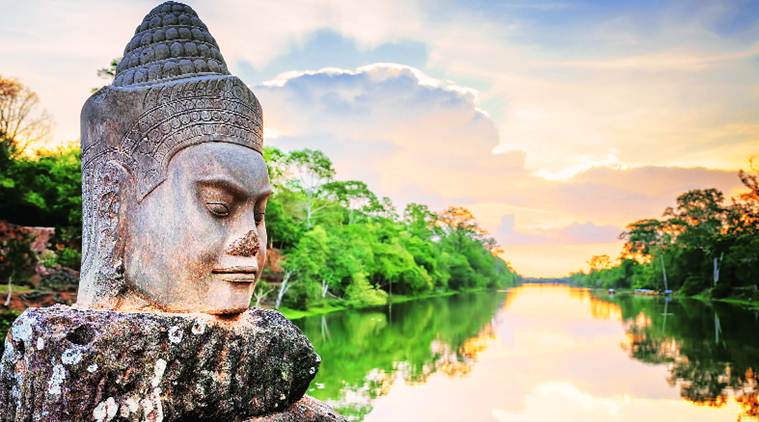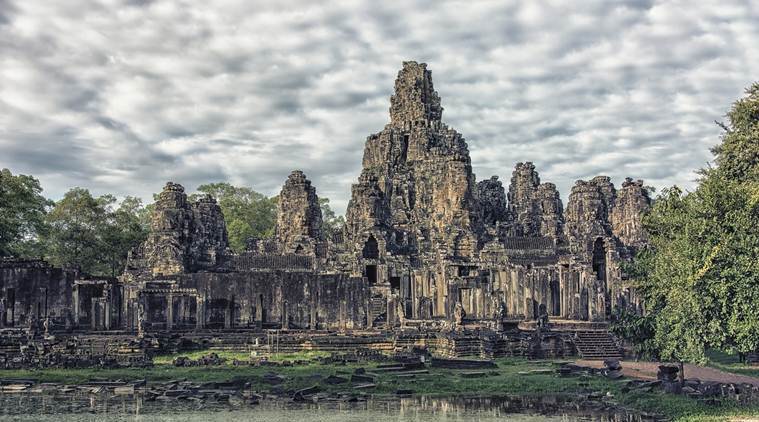- India
- International
Time Stops at Siem Reap
For travel to be memorable, you do not always need a memory stick.
 The mind’s eye: A stone asura near the South Gate of Angkor Thom in Siem Reap, Cambodia
The mind’s eye: A stone asura near the South Gate of Angkor Thom in Siem Reap, Cambodia
Over a month after returning from a vacation in Sri Lanka, I ran into a friend at a party. “You are in town?” she exclaimed in surprise. I sheepishly admitted that I had returned long ago to the humdrum reality of Kolkata. It was only my Instagram feed that was still stuck in Sri Lanka, posting pictures of sunsets over Sigirya rock, colourful sambals and adorable baby elephants. “What to do?” I said. “How many more photographs of picturesquely mouldering Kolkata houses can I keep posting?”
I could pretend this was just about savouring a holiday long after it was over. But, in reality, this was also about social media anxiety, the self-imposed pressure to keep my Instagram feed colourful and happening. A vacation these days is only as good as its social media feed.
The word vacation comes from the Latin “vocare” or “to empty”, to indicate a time free from the routines of daily life, an empty slate.
But social media abhors a vacuum and we have learned to turn our vacations into a parade of non-stop fabulousness. If it looks anything less than spectacular, there’s always a filter to fix that — to make that sunset a little more fiery and that gourmet meal a bit more eye-poppingly yummy.
Once vacations were a black box we disappeared into. We sent picture postcards, which usually reached long after we returned. Sometime the photographs, taken on film, came out overexposed, entire holidays lost in a blaze of white. Occasionally, we had forgotten to move our fingers out of the way or precious pictures turned out blurry. We had to pick and choose the images to save because photo albums, unlike the Google cloud, had limited space. Now holidays unfold in real time, appreciated and “liked” instantaneously by far-flung friends and family. And, yes, envied by them. Don’t lie, that’s why you posted that selfie from your business class seat on your transatlantic flight and from inside the Platinum Lounge at the airport.

That’s not to deny social media can be a boon. A friend can see your picture on a street in Hoi An and tell you where to get the world’s best banh mi sandwich. A cousin, also passing through Goa at the same time as you, can meet up for an impromptu cocktail. But somewhere along the way, travel is becoming consumed by its own hashtags.
In quaint Fort Galle, I spotted Chinese tourists in local saris and gauzy dresses, posing like supermodels in front of every landmark, every ocean viewpoint, every old church while their husbands, laden with expensive cameras, took countless photographs. The women looked at the camera. The men looked at the women. The 17th century fort was just a backdrop. Everything becomes fodder for a social media moment, even an active volcano. A woman in a skimpy bathing suit stands on the edge of an infinity pool gazing at Mount Agung in Bali spewing out plumes of smoke, a natural disaster put to use as backdrop for a sexy Instagram photoshoot, a bonfire of vanities. Or there’s @Traveling_Butts, the gay American couple and minor Instagram celebrities, who thought it was a fun idea to drop their trousers and bare their rear ends wherever they went. When they did it in a temple in Thailand, they were arrested at the airport in Bangkok and charged with public indecency.
 Angkor Thom in Cambodia.
Angkor Thom in Cambodia.
I am as guilty as the next person of being on the social media treadmill while I travel. Let he who is without a selfie stick cast the first stone. When I arrive at a hotel in a new city, the first question is not about a restaurant recommendation from the concierge but about the WiFi password.
Of course, there’s no turning back the clock. Only Luddites would want to do so. I don’t want to hold negatives up to the light and peer at them to document my travels. But I am learning once again to look at the world through my own eyes, rather than through an iPad, that an evening that’s not been Facebooked can still be a memorable evening.
On a trip to Cambodia, we decided to upend our itinerary and turn three days in Siem Reap into a week. We ventured far beyond Angkor Wat to other temples tucked away into the countryside, ruins lost in the jungle. We climbed hills and found ancient images of Vishnu carved into the bed of a crystal-clear mountain river. No one would be interested in all those images of lost temples but as we tuk-tuked past paddy fields, a different country opened up to us — with forlorn temples, abandoned to monkeys and monitor lizards, and roadside lunch places unmarked by TripAdvisor reviews. On a vacation in Vietnam, we spent a couple of days in the far-flung Con Dao islands, an old penal colony, Vietnam’s answer to the Andamans. There was little to do there, few sights. At night, the only entertainment was young people washing down fresh mussels and clams with cold beer at the night market and calling us to join them for some karaoke. In Sri Lanka, we found ourselves in a treehouse without WiFi in the room. Instead, there was a hammock outside and a chorus of crickets.
But the moment I will always remember is on an assignment in the temple towns of Maharashtra. In Tuljapur, home to Goddess Bhavani, a young priest invited me to come back at night. It would be a full-moon night and the goddess would venture out in her palanquin. Cameras were not allowed but we smuggled ours in anyway for this was a not-to-be-missed opportunity. It was a rain-washed night, with lightning flashing dramatically in the dark sky as thunder rumbled across the plains. At 10, the goddess appeared with her tiger mount. A priest smeared a sindoor tika on my forehead. The drums started to beat, the cymbals clanged and we started walking around the rain-washed courtyard, while ecstatic crowds jostled for her blessing through the incense smoke. I had never imagined, in all my life, I would ever end up as a palanquin bearer to the gods.
Nothing remains to document that night. We did not take any pictures, the contraband camera stayed in its case. In social media terms, it was a wasted evening, a washout. But I experienced it with every pore of my being. I learned that for something to be memorable, you do not always need a memory stick. I still remember the priest’s face when I asked if we could lend a shoulder to the goddess.“Why not?” he said with smile.
The young priest gave us each a small piece of peda at the end of it. I did not Facebook it, or Instagram it or tweet it. No one got to “like” it except me but I still remember its crumbly sweetness. At the end of the evening, it felt blessed.
Sandip Roy is the author of Don’t Let Him Know.
Apr 27: Latest News
- 01
- 02
- 03
- 04
- 05




































